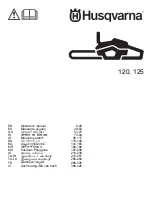
15
English
1. Place the chainsaw on level ground and ensure that
no objects or obstructions are in the immediate vicinity
that could come in contact with the bar and chain.
Note:
the saw chain will rotate during starting.
2. Hold the front handle firmly with your left hand and put
your right foot onto the base of the rear handle. Do not
drop start the chainsaw as injury may result.
To start a cold engine:
1. Turn on the ignition switch.
2. Make sure the chain brake is in the run position by
pulling back on the lever/hand guard.
3. Fully press and release the primer bulb at least 7
times.
4. Pull choke lever all the way out to START position.
5. When the temperature is above 10°C, pull the starter
grip until the engine attempts to start, but no more than
3 times. When the temperature is below 10°C, pull the
starter grip until the engine attempts to start, but no
more than 5 times.
6. Push choke lever to RUN position. Pull starter grip until
engine runs.
Note: Allow the saw to run in this position 15-30
seconds, depending upon the temperature.
7. Depress the trigger release and squeeze and release
the throttle trigger to return the engine to idle after a
total run time of at least 30 seconds.
To start a warm engine:
1. Turn on the ignition switch.
2. Make sure the chain brake is in the run position by
pulling back on the lever/hand guard.
3. Pull choke lever all the way out and then return to the
run position. This will engage the fast idle.
4. Pull starter grip until engine runs, but no more than 5
times. If engine does not start after 5 pulls, use cold
engine starting procedure.
5. When the engine starts, squeeze and release the
throttle trigger to disengage the fast idle and return the
engine to its normal idle.
STOPPING THE ENGINE
See Figures 7 and 14.
release the throttle trigger and let the engine return to
idle. to stop the engine, move the ignition switch to the
stop
(0) position.
Do not put the chainsaw on the ground
whilst the saw chain is still moving.
For additional safety,
set the chain brake when the saw is not in use.
In the event that the ignition switch will not stop the saw,
pull the choke lever out to the fully extended position
(Full Choke)
and engage the chain brake to stop the
engine. If the ignition switch will not stop the saw when
set to the
stop
position, have the ignition switch repaired
before using the chainsaw again to prevent unsafe
conditions or serious injury.
Note:
When you are finished using the saw, always
relieve tank pressure by loosening, then retightening, the
chain lubricant and fuel caps. allow the engine to cool
before storing.
ADJUSTING IDLE SPEED
See Figure 15.
n
If the engine starts, runs, and accelerates, but will
not idle, turn the idle speed screw
“T”
clockwise to
increase idle speed.
n
If the chain turns at idle, turn the idle speed screw
“T”
counterclockwise to reduce the idle RPM and stop
the chain movement. If the saw chain still moves at
idle speed, contact an authorised service centre for
adjustment and discontinue use until the repair is
made.
WARNING
tHe saW CHaIn sHOulD neVer turn at
IDle. serious personal injury may result from the
saw chain turning at idle.
PULL AND PUSH
See Figure 16.
the reaction force of the saw is always opposite to the
direction the chain is moving. thus, the operator must
be ready to control the pull when cutting on the bottom
edge of the bar and the pusH when cutting along the
top edge.
Note:
the chainsaw has been fully factory tested. It is
normal to find some slight lubricant residue on the saw.
kICkBACk PRECAUTIONS
See Figures 17 - 18.
rotational kickback occurs when the moving chain
contacts an object at the Kickback Danger Zone of the
guide bar. the result is a lightning-fast reverse reaction,
which kicks the guide bar up and back towards the
operator. this reaction can cause loss of control, which
can result in serious injury.
PREPARING FOR CUTTING
PROPER GRIP ON HANDLES
See Figure 19.
see
General Safety Rules
for appropriate safety
equipment.
n
Wear non-slip gloves for maximum grip and protection.
n
Hold the saw firmly with both hands. always keep your
left hand on the front handle and your right hand on
the rear handle so that your body is to the left of the











































